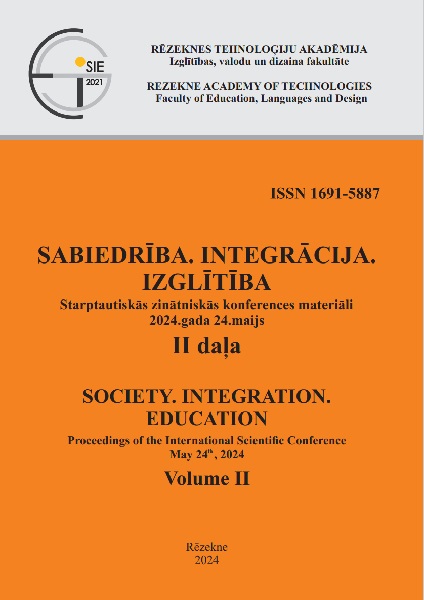INTEGRATION OF MUSIC AND ART: SOME ASPECTS TO TEACHING HISTORY OF ART
DOI:
https://doi.org/10.17770/sie2024vol2.7800Keywords:
Art Nouveau, composition, integrated Approach, landscape, parallels of creative workAbstract
One of the trends in the process of updating the contemporary education is the use of the integratd approach to teaching. The integrated approach to teaching creates the environment which helps learners to understand relations between the areas of content of different arts. This approach is first and foremost oriented towards the development of learners’creative thinking and imagination.
The program developed for teaching potential designers in Daugavpils University includes courses on history of Art. The History of Art operates with such common art categories as harmony, rhythm, genre, form, style, content, contrast, imaginative contrast etc. Being aware of mutual links between such arts as painting and music will develop understanding about associative imaginary links of the language of artistic expression. Comprehension of composer’s or painting’s creative work or an individual composition within the context of spiritual quest of the epoch allows us to broaden our perceptions about general regularities of the development of historical processes and art in one or another historical period. Those developmental periods of art, when the interaction between its different kinds was the most intensive and satiated the whole cultural aspect of the epoch (romanticism, impressionism, expressionism), attract the greatest attention. In music literature, the most delicate form of sound patterns is manifested in musical landscapes. Natural phenomena, due to their nature, can be not only seen but also heard, and therefore, the range of their reflection in music is tremendously broad. The research aim based on an integrated approach to teaching, to research the interaction between music and painting, as example using the creative work of Latvian landscapist Vilhelms Purvītis and Latvian composer Alfrēds Kalniņš. The paper focuses on the possibility to integrate art and music in the context of enrichment of students’ knowledge and skills.
References
Alfrēds Kalniņš. Retrieved from: https://enciklopedija.lv/skirklis/32645-Alfr%C4%93ds-Kalni%C5%86%C5%A1
Hargreaves, D. (2017). The psychology of musical development. Cambridge: Cambridge University.
Hübenthal, U. (1994). Interdisciplinary thought. Issues in Integrative Studies, 12, 55-75.
Humphreys, A., Post, T. & Ellis, A. (1981). Interdisciplinary Methods: A thematic approach. Santa Monica, CA: Goodyear Publishing Company.
Jacobs, H. H. (1989). Interdisciplinary Curriculum: Design and implementation. Alexandria, VA: Association for Supervision and Curriculum Development.
Klein, J. (1990). Interdisciplinarity: History, theory, and practice. Detroit, MI: Wayne State University Press.
Klotiņš, A. (1979). Alfrēds Kalniņš. Komponista dzīve un darbs. Rīga: Liesma.
Kļaviņš, E. (2000). Vilhelma Purvīša ainava eiropeisko tradīciju kontekstā. Vilhelms Purvītis 1872. – 1945. Rīga: Neputns, 174.-188. lpp.
Lake, K. (1994). Integrated Curriculum. In School Improvement Research Series, 16. Retrieved from https://educationnorthwest.org/sites/default/files/integrated-curriculum.pdf
Lemberga, D. (2000). Vilhelms Purvītis – dzīve un māksla. Vilhelms Purvītis 1872.-1945. Rīga: Neputns, 9.-56. lpp.
Lipson, M., Valencia, S., Wixson, K., & Peters, C. (1993). Integration and thematic teaching: Integration to improve teaching and learning, Language Arts, 70(4), 252-264.
Pujate, I. (2000). Vilhelms Purvītis un jugendstils. Vilhelms Purvītis 1872.-1945. Rīga: Neputns, 162.-170. lpp.
Nazaykinsky, E. (1972). O psihologii muzikalnogo vosprijatijan. Мoskva: Muzika.
Vanslov, V. (1983). Izobrazitelnoe iskusstvo i muzika. Leningrad: Hudoznik RSFSR.
Vilhelms Purvītis. Retrieved from: http://www.makslasvesture.lv/index.php/Vilhelms_Purv%C4%ABtis
Vilhelms Purvītis. Fotoportrets. 1938. Retrieved from: http://www.makslasvesture.lv/index.php/Att%C4%93ls:Purvitis_foto_2.jpg
Vilhelms Purvītis. Rīts Rēvelē. Retrieved from: https://arterritory.com/lv/vizuala_maksla/raksti/26156-17_fakti_par_vilhelmu_purviti/
Vilhelms Purvītis. Mēness nakts. Retrieved from: http://www.makslasvesture.lv/index.php/Att%C4%93ls:Purvitis_Meness_nakts.jpg
Vilhelms Purvītis. Rudens noskaņa. Retrieved from: http://www.makslasvesture.lv/index.php/1890_%E2%80%93_1915:_Ikonogr%C4%81fija
Vītoliņš, J. (1968). Alfrēds Kalniņš. Rīga: Liesma.






